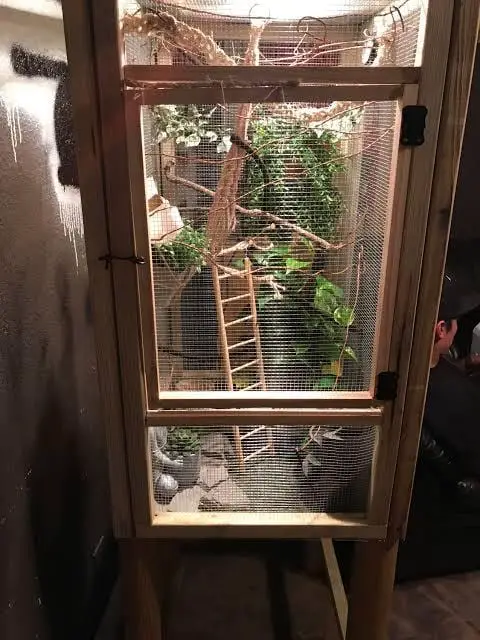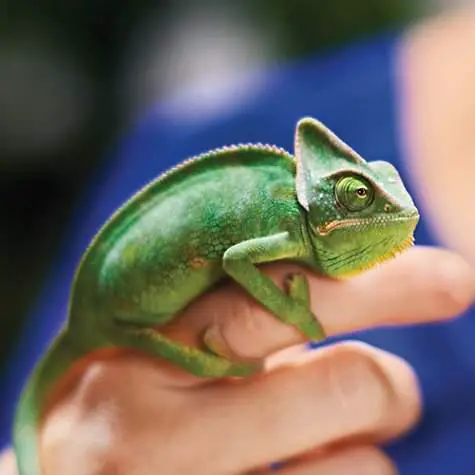Finding the right pet for yourself can be a challenge if you feel like trying to care for one that is not the usual choice. Animals that are known to be “exotic” pets require as much love and attention as any other pal you would have around the house. However, they have special needs and are often under the care of experienced owners.
The chameleon, which is a popular pick among exotic pets, are fascinating and bright creatures that can be suited for any owner when you get the hang of caring for other reptiles. Still, plenty of time and research, you can raise a chameleon-like a pro.
To learn more about how to take care of your chameleon, this compilation full of handy tips is here to guide you on how to become the lord of the lizard territory. Let’s get started!
Lizard Lodging
The setting for your pet chameleon’s home is a close recreation of their habitat in the wild. To make sure your color-changing companion is feeling cozy in its make-shift version of the wilderness, it will need the following:
1. The Big Screen
For the terrarium, opt for screen walls rather than glass. The mesh or screen offers better ventilation inside for your chameleon to breathe. Meanwhile, glass can also create reflections (chameleons tend to mistake their reflection for other chameleons) that might cause stress. The screen can also be gripped by their hands, which gives them extra space to climb around.
The screen terrarium should measure up to at least sixteen inches long, sixteen inches wide, and thirty inches high (16 x 16 x 30 inches).
2. Interior Decorating
Simulate a natural environment by decorating the interior. Lay a reptile carpet at the bottom or cover it in coconut fiber or reptile bark about two to three inches deep. Add rocks, branches, and plants inside make climbing and crawling extra fun.
You can shop for these at your local pet store, but you can also choose to look around yourself. The branches should be able to support your buddy – nothing too wide or too skinny. Avoid positioning branches too close to the light source of your terrarium, which could potentially burn the chameleon’s skin.

A homemade at home. A D-I-Y screen cage for pet chameleon’s via Pinterest.
3. Heating Up and Cooling Down
Chameleons are cold-blooded creatures and will adapt to the temperature in their surroundings. That’s why it’s crucial to also be sensitive to their temperature needs and preferences in accordance with their natural or wild environment. To regulate their body temperature, you will need the enclosure to have the right amount of heat. A lamp at the top of the habitat acts out as their daylight and source of warmth and calcium to strengthen their bones. You can purchase a UVA or UVB fluorescent bulb from the pet store that works best for your pal.
Misting the area helps cool the body and serves as a source of drinking water. Set a basking area for the chameleon to get some light and warmth (on the branches and rocks should work), and a separate area for cooling off – this could be under big plant leaves or shade from large stones. Keeping a thermometer is important to check if the terrarium is at optimal temperature. Misting the space will help balance out the heat and cool.
You can use a spray bottle to do this, but you will have to mist the cage manually several times a day, so installing an automatic fogger, drip system, or mister is more convenient. Using a hygrometer (also known as a humidity gauge) will also check the moisture level inside. The lamp should be kept on for twelve hours and turned off for the next twelve hours to simulate daytime and night time. Depending on the breed of your chameleon, the temperature will depend on what suits best for its health.

Staying Lean and Green
1. Full Nutritional Value
Chameleons eat a wide range of insects such as crickets, wax worms, flies, moths, mealworms, and grasshoppers. The pet store may offer some insects that are ready to eat, but you can always catch these bugs yourself.
You can “gut load” these bugs too if you feel like feeding them so that your buddy gets a packed meal. Since they do a lot of climbing, which requires strong bones, dust the insects they feed on with a calcium supplement two times a week. Know only how much your chameleon can consume. Do not overfeed it. Remove any leftovers that might rot inside the cage.
2. The Extra Boost
Chameleons also eat greens such as mustard greens and collards to offer additional nutrients to their diet. Feed them greens once a day. By giving you chameleons extra boost of veggies, you’ll keep them healthy and happy.
3. Slurp up!
Misting the cage will also be needed for the chameleon to hydrate itself. A chameleon does not drink stagnant water from a bowl and is used to drinking through licking its own skin and dripping water on leaves. If you notice your chameleon licking glossy or objects found in the habitat, mist it completely. This is a sign that the chameleon is feeling thirsty.
Nice and Neat
Making your chameleons clean and neat is a must for health, safety, and well-being. Set a dedicated time to clean your chameleon’s den to ensure that no pest or germs are laying around that may cause infection and other diseases. Here are some tips and tricks to help your pet look neat and nice:
- Have an extra cage or habitat for your chameleon to rest in a while cleaning. Transferring them to a box or environment, they are not used to might only stress it out.
- The entire screen terrarium must be cleaned once a week to avoid your chameleon from getting sick. Remove all the plants and accessories inside the cage. Throw out any leftover food and water.
- You can make a cleaning solution for the habitat from mixing a small amount of mild dish soap and water. Be sure to brush the mesh well and let it dry out to kill any bacteria. Have a cleaning cloth, brushes, and other cleaning supplies in one spot for quick and easy cleaning.
- The flooring, such as coconut fiber, reptile bark, or reptile cart, needs to be replaced at least once a month. Remove the scraps first and thoroughly clean the floor before putting down a fresh layer.
- Return the plants, rocks, branches, and other accessories. Make sure the terrarium is at its optimal temperature for the chameleon before bringing it back inside.
Handling and Personality
Chameleons have different personalities from other animals. If you want to adopt a chameleon, make sure that you know how to handle its personality. Keeping yourself abreast with the knowledge and skills on how to handle them will make you a more responsible pet owner and keep your pet happy and healthy. Learn more about handing such pet by checking the good-to-know facts below:
- Chameleons are solitary animals and can be aggressive or stressed even around their own kind. Do not let them share a cage with another creature or even a chameleon.
- If you own a female chameleon, have a “nesting spot.” Females tend to lay eggs even if they are not fertilized, so have an area where she can lay and bury her eggs. You will notice she might keep going around the habitat, searching for a spot to nest. Some owners offer a nesting bin but handle the chameleon carefully if you plan to take it out.
- Keep your hands clean. Even if you think your pet is clean because of the constant misting it gets, it may still carry germs and bacteria that can make you sick. Your own germs might also cause a chameleon to feel under the weather. Always wash your hands before and after playing with your chameleon.
- Gentle touch. Despite spending most of their time climbing and crawling, chameleons actually have soft bones in their legs. If not handled properly, they can be easily injured. Handle them with care as they tend to keep climbing even outside the cage, so keep your hands ready.
Video Source: Youtube
Conclusion
Intimidating and challenging it may seem, your effort and dedication are vital to keeping a chameleon living a long and healthy life. When in doubt, immediately seek help from your veterinarian to address your concerns properly. Keep a close eye on your pet for anything you think needs to be checked upon. Most of all, what matters is that you have fun with your pal and give it all the love and care you’ve got to create a bond that will stay even when your chameleon’s colors change.



